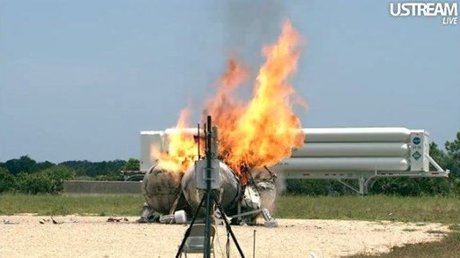NASA's 'Green' Planetary Test Lander Crashes

Earlier this week NASA safely landed a robotic rover on Mars about 150 million miles (241.39 million kilometers) away. But on Thursday here on Earth, a test model planetary lander crashed and burned at Kennedy Space Center in Florida just seconds after liftoff.
The spider-like spacecraft called Morpheus was on a test flight at Cape Canaveral when it tilted, crashed to the ground and erupted in flames. It got only a few feet up in the air, NASA said.
NASA spokeswoman Lisa Malone said it appears that the methane-and-liquid oxygen powered lander is a total loss. Nobody was hurt in the unmanned experiment and the flames were put out, she said.
NASA suspects a mechanical device that is part of its GPS navigation system, spokeswoman Brandi Dean said.
So far NASA has spent $7 million on the Morpheus program, but that includes parts for a still-to-be-built second lander.
Morpheus is a prototype for a cheap, environmentally friendly planetary lander. Thursday was the first time it had been tested untethered in a free flight. It had performed 19 flights at Johnson Space Center in Houston, where it was designed and made, and one more in Florida, but it was always tethered to a crane, Dean said.
The testing moved from Texas to Florida last week and Morpheus had a successful tether test on Friday. NASA had planned to run tests for three months. The plan was for flights over a specially created field designed to mimic the surface of the moon, with boulders, rocks, slopes and craters.
The lander was built mostly with low-cost, off-the-shelf materials. It was an attempt by NASA to use cheaper, more readily available and environmentally friendly rocket fuel. The space agency was considering it as a potential lander for places like the moon or an asteroid, figuring it would carry a human-like robot or small rover.
NASA promoted Morpheus as a "green" project because methane is more environmentally friendly than the toxic rocket fuels it uses. Methane, which is the main component of natural gas, is also cheaper and could even be made from ice on the moon or Mars, NASA figured.
Morpheus was early in the NASA experimental "test bed" process and the space agency hadn't committed to using the lander in any specific flight, NASA officials said.
NASA has parts and plans to build a second Morpheus lander, Dean said: "Hopefully, we'll be testing again before too long."



